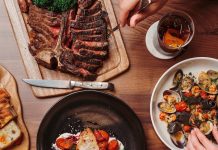In the 1980s, I worked at the Kansas City Times, not far from Arthur Bryant’s, the famed rib and barbecue joint that Calvin Trillin, the New Yorker writer and author of food books, elevated to a par with haute cuisine, declaring it to be “…the single best restaurant in the world.”
The single best restaurant in the world was, back then, a simple storefront in the old African-American section of Kansas City, a little run-down inside with small four-person Formica tables, rickety chairs, paper napkin holders, squeeze bottles of sauce on the counter and a trash can in which to dump your junk. And a never-ending long line of people waiting to be served over the grill counter.
Bryant’s was created in the 1920s by Arthur’s older brother, Charles, and for years it fed an American cultural icon of the 1930s: Clients of the row of nightclubs at 12th and Vine a few blocks away where the Kansas City sound of jazz began and produced legends such as Count Basie, Jay McShann, Mary Lou Williams, Lester Young, Ben Webster and many others.
When Bryant died in the early 1980s, the newspaper ran an editorial cartoon of him at the pearly gates with his briefcase. St. Peter has an anxious look on his face and asks: “Did you bring sauce?” Such was the love for the man and this American cuisine to which he brought such great respect.
On many a day, someone in the Times newsroom would make a run to Bryant’s for the hugest, thickest, most glistening fatty brisket beef sandwiches, book-ended by doubled-up slices of white Wonder-type bread, and dressed with just one pass of the brush of Bryant’s sauce by Richard France, his main counterman and rib oven supervisor. That was all you got, because that’s all it needed. Any extra was on the side.
By the time the sandwich reached the newsroom, the stain of grease and sauce would be spreading through the thick orange-brown paper that was the outside wrapper. You restrained your drooling as you waited for heaven.
I left Kansas City 25 years ago, and I had not drooled for barbecue since until I began anticipating my second visit to Slows Bar BQ on Michigan Avenue, in Corktown, just west of the old Tiger Stadium.
At Slows, the making of ‘cue, as it’s affectionately known by the shorthand of those who love it – and all else – is a very serious thing. This is no ordinary slap-on-the-sauce-and-belch rib place. This is a wider world of ‘cue, carefully studied and offered as American cuisine, wrapped in a bar, set in a boisterous atmosphere with a sense of fun and without pretensions. It also has one of the best lists of fine and exotic beers in the metro area.
Put it all together, and the result is phenomenal. The only thing close is Zingerman’s Roadhouse in Ann Arbor, which opened three years ago as a serious culinary laboratory interpreting American cuisines from around the country. Dish for dish, flavor for flavor, in kitchen skills and presentation in both places, Slows is distinctly better.
It’s that good.
Slows opened last September and has become so popular by word of mouth that a wait for a table can run more than one hour for a menu that includes such dishes as Hoppin’ Jack, a Southern meal popular on New Year’s Day, made with black beans, rice, scallions, tomato and melted cheddar; or an entrée portion of Mac-n-Cheese, macaroni and cheese made with pasta shells, cheddar and Chef Brian Perrone’s secret blend of spices. Or, there’s a smoked beef brisket enchilada that’s out of this world, and a crisp fritter of split pea and okra served on a vibrant, sweet and vinegary sauce. Slows also has the best coleslaw and potato salad I have had in years.
Perrone, who trained in Chicago and cooked at La Sardine, Zealous and other Chicago restaurants, created Slows with partners Philip Cooley and Dean St. Souver. In Detroit, Perrone’s restaurant experience includes Coach Insignia in the GM headquarters in downtown Detroit, No. VI Chop House in Novi, and the Atlas Grill on Woodward in Detroit.
Slows is located in a refurbished, high-ceiling brick building at the corner of 14th and Michigan. A U-shaped copper-top bar divides the dining room with its walls of exposed brick and lots of windows providing natural light by day, and lit by soft accent lights at night. An outdoor terrace was opened this month for summer dining.
“At first we wanted to do fine dining,” Perrone says. “But eventually I said, ‘Let’s do barbecue.’ It’s such an untapped niche, and there just isn’t a lot of it around the city. And the response has been amazing from the day we opened.”
To figure out how best to do ‘cue, and how best to structure the menu so that it would have the appeal of being serious, Perrone began touring the country to visit the best barbecue restaurants and chefs with the loftiest reputations in the country.
“What I found was a lot of good stuff. But a lot that didn’t impress me much, either – and some were big names,” Perrone says. Finally, the model that seemed to make the most sense, Perrone says, was in New York City, where barbecue restaurants such as Blue Smoke and Virgil’s have given barbecue “dining” a much higher profile.
The way the food is presented at Slows is very un-‘cue. It’s simple but embraces the flair typical of modern cooking. For example, an appetizer plate of various smoked fish items: smoked salmon, whitefish paté, a chopped salmon seviche, and a simple quinoa salad of honey, balsamic vinegar, minced apricots and julienned McIntosh apple for decoration.
Perrone’s delectable hickory-and-applewood-smoked meats – baby back ribs, pulled pork and the Texas brisket – are never “sauced.” They come to the table naked, right from the Southern Pride smoker in the kitchen, “the best I’ve ever worked with,” Perrone says. Various squeeze bottles are on the table and include a smoky apple sauce, a thick spicy sauce, and a vinegary and zesty North Carolina sauce, among others.
Despite what we might like to think, slow cooking meats with wood smoke isn’t uniquely American. It has been done in France and Germany for centuries. One of the most memorable sandwiches I ever ate was on the grounds of a monastery outside Florence, in northern Italy, where a wild boar had been roasted on an open-fire pit, prepared and then sliced by monks in full robes, and served on thick peasant bread with a mustard-based creamy sauce, and a glass of fresh, new Frascati white wine. Definitely ‘cue.
While wood cooking of meats has remained an exotic way of eating in Europe, on this continent barbecue emerged out of a need to make do with what was around us, and it has grown into the most democratic of all foods. It crosses cultural, political, racial and geographical lines. It’s a food zone into which anyone can fit.
Like baseball, barbecue brings us together. It’s our culinary national pastime. Just listen to the conversations and watch the faces of people eating at Slows.
2138 Michigan Ave. at 14th Street; 313-962-9828, L & D daily.
Cook is the chief restaurant critic of ‚Äúœ„∏€¡˘∫œ≤ Õºø‚◊ ¡œ.‚Äù E-mail: editorial@hourdetroit.com.
|
| Ã˝ |
|








